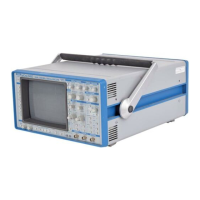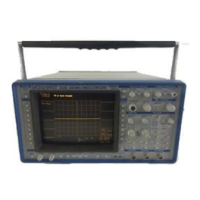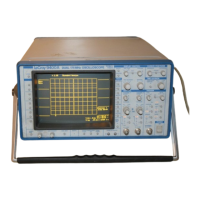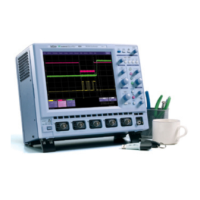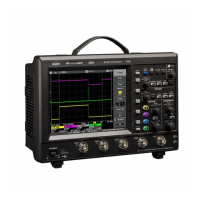10–22
Zoom, Mathematics and Math Setup
Essentially… To achieve a desired FFT span, first make sure that the
sampling rate is more than twice the span desired. Control the
sampling rate using the TIME/DIV knob and set the acquisition
memory length with the “TIMEBASE” menu. The sampling rate
can be further adjusted by limiting the number of points in the
“for Math use max points” menu.
Example Set up the oscilloscope for an FFT with a span of 10 MHz and a
frequency resolution of 10 kHz, to analyze a continuous,
periodic waveform.
1. The required frequency resolution demands a waveform
duration (capture time) of 100 µs. Setting the TIME/DIV to
10 µs achieves the necessary ∆f of 10 kHz.
2. To obtain the specified 10 MHz span, the effective sampling
rate must be > 20 MS/s. On, say, an oscilloscope with a
sampling rate of 500 MS/s, the 50 000-sample default
memory length and a 10 µs TIME/DIV setting would be used
to first give a 250 MHz span. Now, to obtain a 10 MHz span,
the sampling rate must be reduced. This can be done in
either of two ways:
a) In “TIMEBASE”: decreasing the number of samples by
setting the “RECORD UP TO” menu to 2500 results in a
sampling rate of 25 MS/s.
b) With “ZOOM + MATH”, by setting the “for Math use max
points” menu to 2500. This would leave the sampling
rate at 500 MS/s but decimate the waveform data before
the FFT by 20 000:1, thus reducing the effective
sampling rate to 25 MS/s. This would in turn result in a
span of 12.5 MHz, the closest achievable span to
> 10 MHz.
Note: The technique described in b) above is to be
preferred because it maintains a high input sampling rate
and reduces the risk of aliasing the acquired data.
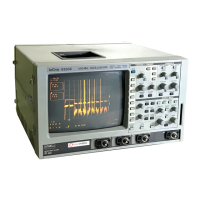
